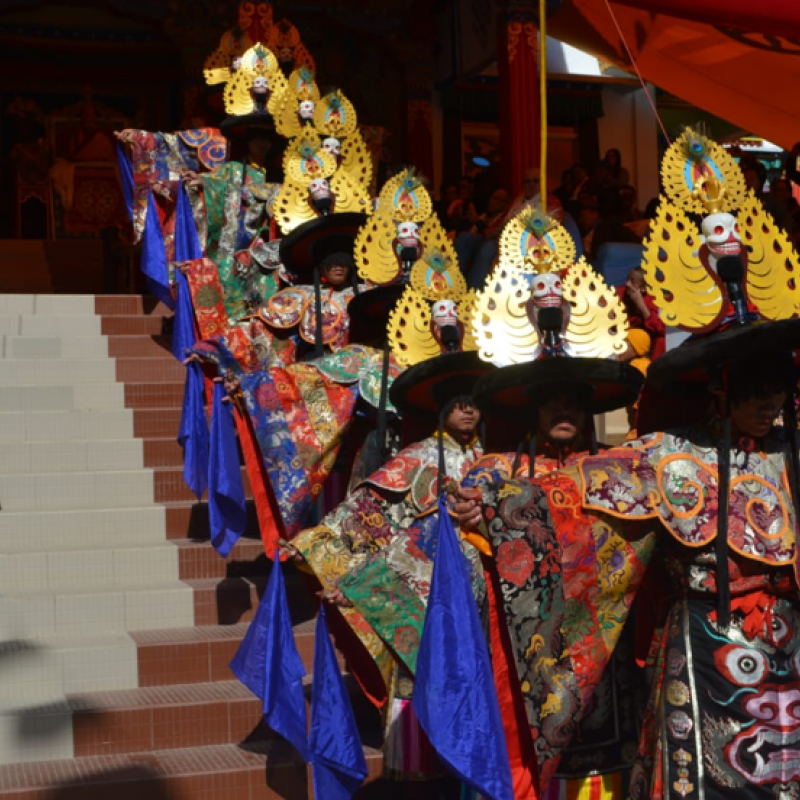The etymological meaning of cham is dance. In the broader context, cham in Arunachal Pradesh can be divided into two categories—pantomime and monastic dance. Both the dances are religious by nature, but the monastic dance is considered more sacred.
Pantomime was originally started by a famous fourteenth-century monk, Chapjam Wangpu.[1] The monk initiated the art of pantomime with a dance called ajilamu, along with other folk dances like the yak dance, deer dance, lion dance, jeipuh and jeimuh, kiangpa and broh. In his pantomimes, elements of monastic cham were covertly present, especially in the myth and the message that the dances revealed.
Monastic cham was started by the saint Padmasambhava. A tradition that goes back 1,300 years, this cham has its origin in Tibetan Buddhist monasteries, and is now actively practised in the Himalayan regions of India, Bhutan, Nepal and Tibet.
The cham practised in the monasteries is a unique ritualistic mask dance, designed as a secret tantric practice, and performed by Buddhist monks and nuns. They are traditionally performed during multi-day religious festivals at the end of the year, with measured cadence and physical vibrancy, various costumes and musical instruments. Invoking wrathful deities, protectors, lokapalas (guardians of the world) and atsaras (acharyas) through chant and performance, the monastic cham is an archetypical tantric practice performed to eliminate evil and detrimental spirits, and reinstate order, peace and harmony in human life and society at large.
In the course of its historical development, monastic cham gradually exceeded its periphery from a narrow religious space to a larger cultural space of public involvement. In this departure, however, the common belief relating to its healing and protective power was not diminished; rather, the widening of territory lent the practice a much-needed mass conviction, marrying monastic cham to ideas like cultural identity and heritage.
The heritage of cham that the monasteries of Arunachal Pradesh have sustained through successive generations is predominantly composed of the age-old tradition inherited from Mahayana/Vajrayana Buddhism along with the elements of pantomime prevalent during the time. The Monpas, Sherdukpen, Bugun, Memba and Khambas are the major tribes practising Mahayana Buddhism in the western part of Arunachal Pradesh. Among them, the Monpas contribute the most to the sustenance of the heritage of cham as a sacred ritualistic dance in both Tawang and West Kameng districts. As a performing art, cham in the monasteries is usually performed in both districts during the Torgya festival, which comes before Losar, the new year of the lunar calendar. It comprises socioreligious practices, ritualistic and festive elements, folk music, traditional craftsmanship and, most importantly, the unique orality and epistemological foundation of Mahayana Buddhism.
Ritual Practices: Similarities and Differences
The heritage of cham in the monasteries of the Mon region[2] of Arunachal Pradesh comprises the socially acknowledged spiritual and historical narratives relating to the purifying and healing power of dance forms, their functional roles in the discourse of religious and greater cultural identity, along with their emblematic avowal of the belief system of the people practising the Buddhism originating from the ancient Nalanda University. In Tawang and West Kameng districts, where cham is a ceremonial practice in monasteries, the tradition has developed through a gradual process of negotiations and interactions with nature, history and environment with their unique content and characteristics. Out of such transactions, the dance has emerged with diversified forms following the belief, rituals and respective roles played by the pioneers of the monasteries.
These transactions are specific to the sect and society within the ambit of which the dance forms developed. Among the Monpas of the two districts, the dance forms practised by the Geluks are different from those by the Nyingmas. For example, the monks perform the roles of the female deities in the dance practised by the Geluks, while the nuns play these roles in the case of the Nyingmas. The features of the dance forms are specific to the communities and their cultural location as well. For example, the dance form that one sees in Nyingma sect’s Gaden Namgyal Lhatse Monastery and Khinmey Monastery in Tawang is different from the one seen in Gontse Gaden Rabgye Lling Monastery in Bomdila, and Chilipam Monastery of West Kameng district. They are marked by distinct ritualistic practices, costumes, masks and worldview.
Although over 50 different varieties of cham are identified in the monasteries of both Tawang and West Kameng districts of Arunachal Pradesh, 20–25 variations of these are commonly practised. In the monasteries of the Geluks of West Kameng and Tawang districts—namely, Gaden Namgyal Lhatse Monastery, Tawang and Gontse Gaden Rabgye Lling Monastery, Bomdila—the main variations of cham practised are phag, zam, grai, lok, ja, jhanak, arpo, gonying, tsog, durdag, shan, le ngan, Dikchung, Khimdak Palkyi, ngag, dung, shawa, gayi, Palden Lhamo[3] and gelong. In the monasteries of the Nyingma sect of the two districts, the types of cham practised include black hat, Guru Tsengye, Choebey Lhamo, Guru Dorjee Drolley, khandu, garur, kuru kulley and dechan karmo. The chams performed by the two sects are not only different in terms of costume, style and physical vibrancy, but also in terms of philosophy and the divinities worshipped.
The two sects, however, share a similar way of preparing the podium in the form of courtyard. This is a practice that they borrow from the large monasteries of Tibet, where ‘The dance area in front of the main hall is marked with a large concentric circle depending on the monastery. Markings are in white chalk or lime.’[4] They prepare the courtyard in geometric forms, with circles, squares and auspicious marks. There are monasteries that have permanent structures for the courtyard, where the pedestal is prepared with white colour. Those without such fixed spaces, use open fields. (Fig.1)
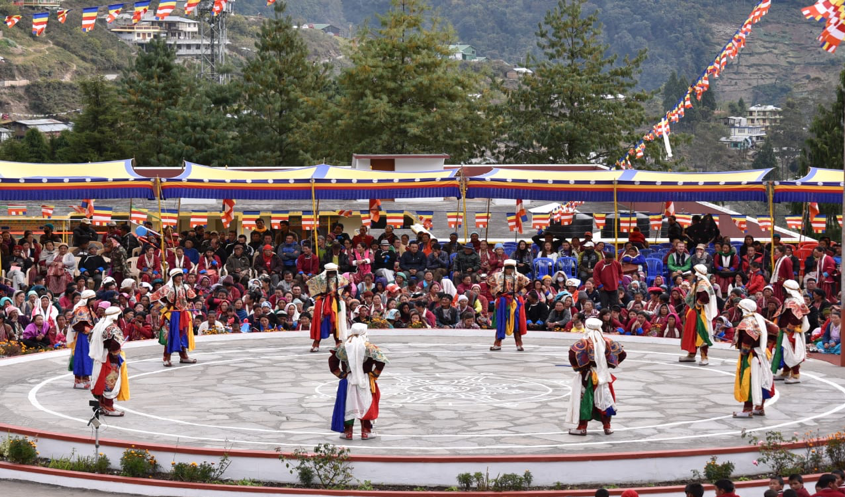
Although the Geluks and the Nyingmas invoke deities in different ways, they do so for the same purposes. The monasteries of the Geluks traditionally start the cham with phag (pig dance) while the Nyingmas start with tordog (a sacrificial ritual), conducted before the Losar, followed by black hat dance. In black hat dance, five dancers perform to purify the earth and welcome Guru Padmasambhava. He is also known as Guru Tsengye, which is why the dance performed to invoke him is called Guru Tsengye or lama cham. This is the leading dance in the Nyingma cham, with performers playing the role of the guru and his eight reincarnations.
Although the cham of the Nyingma sect are diverse, the entire performance has a core structure and follows a specific sequence. Guru Tsengye cham precedes the Choebey Lhamo cham, where 16 choebey lhamos, female dharma protectors of the Nyingma sect, take the stage to offer homage to Guru Padmasambhava and his eight reincarnations. After this, Dorjee Drolley cham is performed. Dorjee Drolley is one of the reincarnations of Padmasambhava. In this dance, four female deities and four dharma protectors perform for the benefit of all sentient beings. The dharma protectors are called lhasin degye and the dance that they perform is rudra rup. In the middle of the dance, the black hat dancers once again enter the podium to offer homage to Guru Dorjee Drolley. This is followed by khandu cham, divided into two parts—Kuru Kulley cham and Dechen Karmo cham, named after two female deities. Their roles are performed by nuns. Devi Kuru Kulley represents self-control over one’s desires, while Devi Dechen Karmo represents peace.
Khandu cham starts with Dechen Karmo appearing on the pedestal with five other deities. (Fig. 2) They are succeeded by 16 other female deities who enter the stage to offer homage to them.
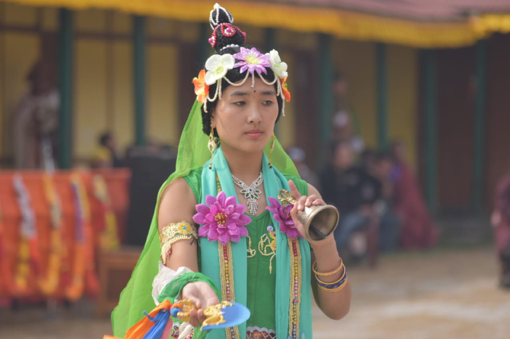
Garuda dance, named after the mythical bird of Hindu, Jain and Buddhist mythology, is a cham performed in the interval between Dechen Karmo and Kuru Kulley. The ever-vigilant and powerful Garuda is a destroyer of snakes, thus the cham has practical significance when performed in the Himalayan region dominated by the reptiles. In the cham performed by the Nyingma sect, Garuda appears in a zoomorphic form, with open wings; by killing snakes, he becomes a dharma protector. (Fig. 3) After the Garuda cham, Devi Kuru Kulley appears on the stage, and Mahadeva and Uma follow her to the pedestal.
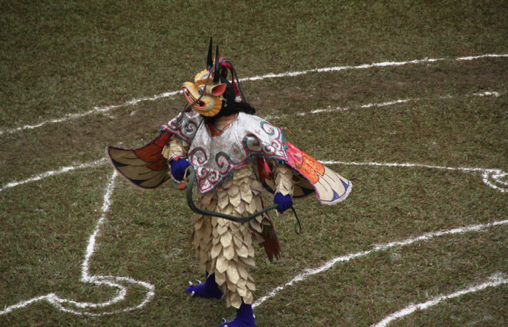
As far as deities and costumes are concerned, the cham tradition maintained by the Nyingmas is influenced by Hindu culture, especially tantric practices. In some areas, the costumes worn by the dancers carry visible influence of central India. This is particularly highlighted by the attires worn by Dechen Karmo and Kuru Kulley. (Fig.4)
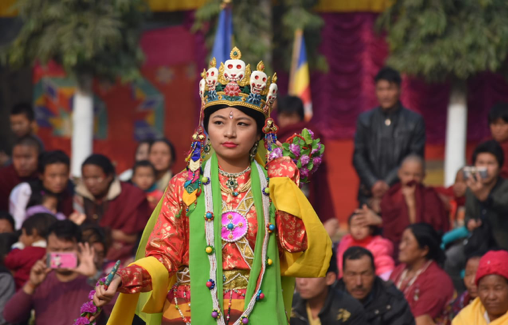
The concept of purification is prevalent in the cham practised by the Geluks. As the Nyingmas start the sequence with invocation, the Geluks start with phag cham in which a pig gets on the pedestal to seek permission from the earth deity or bhumi-devta to begin the cham episode. In the course of the dance, a lang (ox) accompanies the phag to neutralise the evil forces and sanctify the courtyard. (Fig. 5)

However, even within the same sect, certain ritualistic practices differ based on the location of the monasteries. In the Gontse Gaden Rabgye Lling Monastery, Bomdila, after the sanctification of the pedestal, phur cham is performed, where 10 wrathful deities enter the courtyard for inspection. In other variations practised in Tawang, zam cham is performed to neutralise the entire venue before a grai cham performance.
Tantric Influence on Buddhist Art
Tantrism plays a vital role in the cham performances practised in Tawang and West Kameng districts.
Zhanak cham: In zhanak cham the Buddhist monks wear tantric costumes according to Tantrayana Buddhism. It is among the oldest chams in the region, and celebrates the origin of the Geluk school.[5]
Durdag cham: Durdag cham presents the myth of Durthroe Dagpo, where she is a dharma protector who with her industrious effort shielded the Geluk tradition through the ages. Also known as the skeleton dance, in this dance four monk artists wearing skeleton costumes perform as wrathful deities on a mission to rid the earth of evil spirits (Fig. 6)
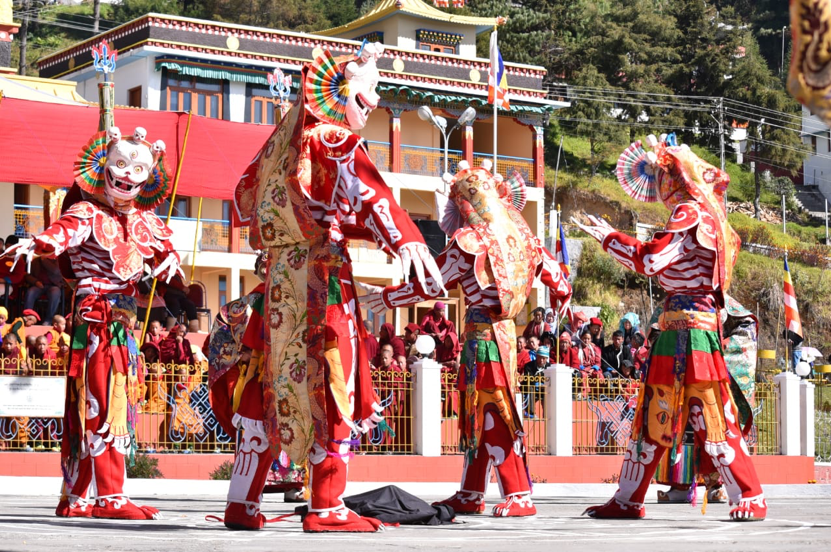
Ngag cham: Ngag cham is important because it dramatises what is believed to be the origin of tantrism in Tibetan Buddhism. According to this story, Indian Buddhist scholar Acharya Shantarakshita advised the Tibetan king to invite Indian tantric masters to spread their philosophy in Tibet, following which tantrism got embedded in their culture.
Gonying cham: Gonying cham is a popular dance in the Mon region, where performers dressed as angels represent the beautiful girls of the region.
Shan cham: Shan cham carries forward the myth of Yamati, who is a mystic protector of Buddhism in the Mon region. It is particularly popular in Gaden Namgyal Lhatse Monastery, Tawang.
Shawa cham: Shawa cham presents the history of Buddhism in the Mon region. It employs dialogue and songs, and is also known as deer dance as it involves performers dressed as a pair of deer. In the folklore of the region, deer is seen as a natural creature of innocence and kindness that does not harm any human being. (Fig. 7)
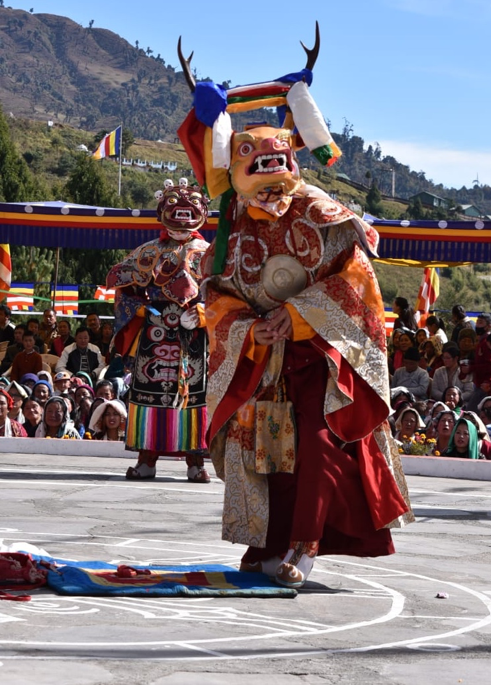
Carriers of Buddhist Worldview
As is the case with all forms of art that have religious connotations, cham too is used to further Buddhist moral preaching.
Dikchung cham presents the story of a person named Dikchung, who lived an unreligious life, full of vices. A morally corrupt being, he was a cruel hunter and a liar. The dance presents his life story emphasising the punishment that he receives in hell according to his karma. In gayi cham, the rivalries between the villages in ancient times are dramatised. This dance is also loaded with ethnic tastes and characteristics.
At the opposite end of Dikchung cham is Khimdak Palkyi, where the story of this virtuous and religious character is performed to show the importance of virtuous deeds that leads to arathood (to attain nirvana). Although Palkyi met the Buddha at the age of 100, he achieved arathood because of sincere practices and persistent faith.
There are many other dance forms that equally celebrate Buddhist worldviews and dominant principles. One such dance practised in Arunachal Pradesh is jac cham. The Buddhist views of pacifism and harmony as well as karma and interdependency are revealed through this particular dance form. The dance demonstrates the need for empathy towards animals and shows how animal slaughtering can create suffering in human lives. The Buddhist idea of karma is also central to le ngan cham, which demonstrates how misdeeds affect sinners in hell. The sinners of the human world are punished by various demonic figures wearing the masks of different animals. These demons are the authorities of hell. The gelong cham dramatises the Buddhist concept of 12 zodiac signs.
The inherent philosophy of cham reveals that the entire sequence of the performance is purely didactic and has strong sensuous appeal. The cham teaches the need to live according to the essential Buddhist doctrines of non-violence, positive karma and the essence of dharma. It deals with the routes leading to the emancipation from samsara and the ways and importance of eliminating the evil forces from it. The culmination of that philosophy of samsara is the Palden Lhamo cham, where the deity is requested by the 12 monk performers and her guards to assist them to establish peace and order in samsara. In the course of the dance, her two guards, Chusin Dongchen and Senge Dongchen, accompany Palden Lhamo. Chusin wears the mask of a crocodile and Senge wears a lion’s mask. When the dance begins, the two assistants enter the pedestal and Palden Lhamo comes from the main prayer hall of the monastery. When she takes her throne, the monk artists request her support to establish peace and concord in samsara for entire humanity.
Conclusion
Cham in the monasteries of Arunachal Pradesh has maintained the Mahayana and the Vajrayana traditions in different forms and aspects, along with diversified folk elements of pantomime and mythical stories transmitted orally over generations. Pantomime is older than the cham practised in the monasteries. In fact, they predate the construction of the monasteries. So, their inclusion of monastic lore tells us that the mythical tales of the cham are older than the built structures that they came to inhabit in the seventeenth century.
Eventually, there was a split, as the dance form transcended the built structures. Though both in its monastic and ‘secular’ form it is imbued with religious flavour, over time, the cham maintained by the public became more popular.
Notes
[1] Chapjam Wangpu was a fourteenth-century monk of Arunachal Pradesh. He was a bridge maker and was also known as Drubthop Thangtong Gyalpo. According to legend, Chapjam Wangpu was helped by a spirit in the construction of bridges. See Sharma, ed., Tawang, 71–89.
[2] In Arunachal Pradesh, the Buddhist-dominated southern Himalayan forest areas are called the Mon region. Both Tawang and West Kameng Districts fall within this region.
[3] There are eight dharmapalas in the monastic cham practised by the Geluk sect; out of them, Palden Lhamo is the only female deity. One of the avatars of Palden Lhamo is Chamundi. She is also known as Sri Devi, who is one of the chief protectors of dharma and the samsara.
Bibliography
Ahir, D.C. Heritage of Buddhism. Delhi: Buddhist World Press, 2010.
Sharma, Atul Dev, ed. Tawang: The Abode of Prayers. New Delhi: Department of Culture, Government of India, 2003.
Trimble, G. William. Tibetan Cham Dance: A Traveller’s Guide. Canada: DCG International Publishing, 2011.
Wayman, Alex. The Buddhist Tantras: Light on Indo-Tibetan Esotericism. Delhi: Motilal Banarsidass, 2005.
